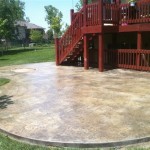How To Build A Stone Patio
Constructing a stone patio enhances outdoor living spaces, providing an attractive and functional area for relaxation, entertainment, and dining. This article provides a detailed guide on how to build a stone patio, encompassing preparation, material selection, and installation techniques. A well-built stone patio adds value to a property and offers a durable, low-maintenance surface for years to come.
Planning and Preparation
The initial phase of building a stone patio revolves around meticulous planning and thorough preparation. This stage significantly impacts the patio's structural integrity and aesthetic appeal. It is crucial to consider the dimensions, layout, and drainage of the area.
Site Assessment: Begin by evaluating the chosen location. Mark the intended boundaries of the patio using stakes and strings. Assess the existing ground level. If it is uneven, consider the amount of excavation or fill required. Determine the soil type, as this will influence the base materials needed. Clay soil, for example, retains more water and requires a thicker, more robust base compared to sandy soil.
Design and Layout: Develop a detailed design plan that incorporates the desired shape, size, and pattern of the patio. Consider the relationship between the patio and adjacent structures, landscaping, and walkways. The design should also factor in the intended use of the patio, such as dining, lounging, or grilling. Choose a paving pattern that complements the architectural style of the house and the surrounding landscape. Common patterns include running bond, herringbone, and random layouts.
Drainage Considerations: Proper drainage is essential to prevent water from accumulating on the patio surface and causing damage or instability. Ensure that the patio slopes slightly away from the house or any other structures. A slope of approximately ¼ inch per foot is generally sufficient. If the area has poor natural drainage, consider installing a subsurface drainage system, such as a French drain, to divert water away from the patio.
Permits and Regulations: Before commencing any construction, research local building codes and regulations. Some municipalities require permits for patio installations, particularly if they exceed a certain size or alter the existing drainage patterns. Obtain the necessary permits to avoid potential fines or delays.
Materials and Tool Selection
Selecting the appropriate materials and tools is paramount to the success of the patio project. Choosing high-quality materials ensures durability and longevity, while having the right tools streamlines the construction process.
Stone Selection: The choice of stone is a crucial aesthetic and functional decision. Several types of stone are suitable for patio construction, each with its own characteristics and advantages. Flagstone, a natural sedimentary rock, offers a rustic and irregular appearance. Pavers, manufactured from concrete or clay, provide uniformity and ease of installation. Bluestone, a type of sandstone, is known for its durability and distinctive blue-gray color. Consider the color, texture, size, and shape of the stone in relation to the overall design of the patio. When calculating how much stone to purchase, add 10% to your estimated square footage to account for cuts and breakage.
Base Materials: The base material is the foundation of the patio and provides a stable, level surface for the stones. Crushed gravel and landscape fabric are essential components of the base. Crushed gravel, typically ¾ inch in size, provides excellent drainage and compaction. Landscape fabric prevents weed growth and separates the gravel from the soil. The amount of base material required depends on the soil type and the intended use of the patio. A minimum base depth of 4 to 6 inches is recommended for most installations.
Sand or Stone Dust: A layer of sand or stone dust is used to create a level setting bed for the stones. This layer should be approximately 1 inch thick and compacted to provide a smooth, stable surface. Choose a fine, granular material that is easy to work with and compact. Avoid using beach sand, as the salt content can damage the stone over time.
Tools: A comprehensive set of tools is necessary for efficient and accurate construction. Essential tools include:
- Shovels for excavation and material handling.
- Wheelbarrows for transporting materials.
- Tamper or plate compactor for compacting the base and setting bed.
- Level for ensuring a level surface.
- Rubber mallet for setting stones.
- Hand saw or circular saw with a diamond blade for cutting stones.
- Measuring tape and string for layout and alignment.
- Safety glasses and gloves for personal protection.
Installation Process
The installation process involves excavation, base preparation, stone laying, and joint filling. Each step requires precision and attention to detail to ensure a stable and aesthetically pleasing patio.
Excavation: Excavate the area to the required depth, taking into account the thickness of the stone, the setting bed, and the base material. Ensure that the excavation extends beyond the perimeter of the patio to accommodate edging or borders. Remove all vegetation, topsoil, and debris from the excavation site. Compact the exposed soil using a tamper or plate compactor to create a stable subgrade.
Base Preparation: Install landscape fabric over the compacted subgrade to prevent weed growth and separate the soil from the base. Add the crushed gravel in layers, compacting each layer thoroughly. The base should be level and well-compacted to provide a stable foundation for the patio. Use a level to check the grade and ensure that the patio slopes slightly away from the house or other structures.
Setting Bed Installation: Spread a layer of sand or stone dust over the compacted gravel base. Use a screed board to create a smooth, level surface. The setting bed should be approximately 1 inch thick and consistently level across the entire patio area. This layer provides a cushion for the stones and allows for minor adjustments during installation.
Stone Laying: Begin laying the stones according to the chosen pattern. Start at a corner or edge and work your way across the patio. Use a rubber mallet to gently set each stone in place. Ensure that the stones are level and aligned properly. Use shims or additional sand to adjust the height of individual stones as needed. Leave a small gap between each stone to allow for joint filling. For irregular stones, such as flagstone, take time to arrange them in a visually appealing pattern, considering the size, shape and color variations of each stone.
Cutting Stones: Cutting stones becomes necessary when fitting stones around the perimeter or adjusting the layout. Use a hand saw or circular saw with a diamond blade to cut the stones to the desired shape and size. Always wear safety glasses and gloves when cutting stones to protect yourself from injury. Score the stone lightly before making a full cut to prevent chipping or cracking.
Joint Filling: Once all the stones have been laid, fill the gaps between them with sand, stone dust, or polymeric sand. Polymeric sand is a mixture of sand and polymers that harden when wetted, creating a durable and weed-resistant joint. Sweep the joint-filling material into the gaps using a broom. Compact the joints using a plate compactor or a hand tamper. Water the patio thoroughly to settle the joint-filling material and activate the polymers in polymeric sand. Be careful not to overwater, as this can wash away the joint-filling material.
Edging and Borders
Edging and borders provide a finished look to the patio and prevent the stones from shifting or settling over time. Several options are available, including concrete edging, brick borders, and natural stone borders.
Concrete Edging: Concrete edging is a durable and cost-effective option. Install the edging along the perimeter of the patio, ensuring that it is level with the surface of the stones. Secure the edging with stakes or concrete anchors. Backfill the area behind the edging with soil or gravel to provide additional support.
Brick Borders: Brick borders add a decorative touch to the patio. Install the bricks along the perimeter, setting them in a mortar bed. Ensure that the bricks are aligned properly and level with the surface of the stones. Consider using a contrasting color or texture of brick to create a visually appealing border.
Natural Stone Borders: Natural stone borders offer a rustic and natural look. Use larger stones to create a border around the patio. Set the stones in a mortar bed or dry-stack them, depending on the desired aesthetic. Ensure that the stones are stable and well-supported.
After completing the installation, clean the patio to remove any excess sand, stone dust, or mortar. Inspect the patio for any loose or uneven stones and make any necessary adjustments. Allow the patio to settle for a few days before placing furniture or other heavy objects on it.

How To Build A Patio In Weekend Finegardening

How To Lay A Stone Patio Designs Stones Design

How To Build A Flagstone Patio In One Day Merrypad

How To Build A Patio An Easy Do It Yourself Project

How To Prep Lay A Base For Pavers Western Interlock

How To Build A Flagstone Patio Greenacresodfarm Com

How To Build A Paver Patio It S Done Young House Love

Handy Steps To Install Stone Patio In Your Home Outdoor

Installing A Diy Paver Patio Is The Ultimate Spring Project

Diy Pea Gravel Patio With Pavers Love Renovations
Related Posts








